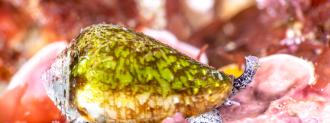Researchers at Florida Atlantic University have found evidence that cone snail venom could potentially treat severe malaria, according to a new study published in the Journal of Proteomics.
The snail’s toxic weapon could help prevent red blood cells, previously infected by the malaria parasite, from glomming on to the layer of cells that protects major organs. This can cause complications even after the parasite itself has been treated.
The Sting of the Snail
Cone snails are a family of marine molluscs whose cyclone-shaped shells shield a squishy hunter — which can be extremely venomous. Their sundry venoms — called conotoxins — are composed of a whole host of nasty peptides, delivered via a hollow barbed tooth that acts as “both harpoon and hypodermic needle.”
Once someone is bit by the snail — often when handling the admittedly comely creatures — a range of horrible symptoms may result.
Cone snails that hunt fish have the most potent conotoxins and are most dangerous to humans, according to doctors Sasha Kapil, Stephen Hendriksen, and Jeffery S. Cooper (of the Indiana University School of Medicine, Hennepin County Medical Center, and University of Nebraska Medical Center, respectively).
“The initial symptoms of envenomation vary depending on the species of cone snail and the victim,” they wrote. “When stung by a piscivorous (fish-hunting) cone snail, one may feel anything from a sharp pricking sensation to unbearable pain.”
At the injection site, local numbness may set in, and skin may turn blue or die. From there, the conotoxins do their work, attacking the neurotransmitter channels that can be found throughout the body. A victim may suffer fatigue, sweating, and vision irregularities, proceeding to general muscle paralysis, cardiovascular collapse, respiratory failure, or coma in severe cases.
“If a patient is untreated,” the doctors wrote, “death is rapid and often occurs within one to five hours.”
So, yeah, you can totally get killed by a snail.
“Among the more than 850 species of cone snails there are hundreds of thousands of diverse venom exopeptides that have been selected throughout several million years of evolution to capture their prey and deter predators,” Frank Marí, the study’s corresponding author, said in FAU’s press release.
But cone snail venom’s ability to influence their victims’ central nervous systems also makes them potential therapeutics — there’s already one FDA-approved painkiller, Prialt, derived from conotoxins, Scientific American reports.
Snails vs. Parasites
Malaria is caused by Plasmodium parasites, which can be transmitted to humans via the bloodsucking bite of an infected mosquito. The disease burden of malaria is immense; the WHO estimates there were 229 million cases in 2019, with 409,000 deaths; cruelly, children under five accounted for 67% of those deaths.
A common pathology of malaria infection is called cytoadhesion: when infected red blood cells stick to the cells that form membranes around our organs and, in pregnant women, the fetus. This can cause serious complications even after the parasite has been cleared from our bodies.
Cone snail venom, the researchers found, may help prevent that cytoadhesion. Conotoxins work by targeting proteins on the outside of excitable cells — like muscle cells and neurons.
The researchers found that six different venom fractions — either one, or a few, of the cone snail venom’s peptides — prevented the most common species of Plasmodium from being able to stick a specific protein to red blood cells. The cells which are covered in this protein are the ones responsible for cytoadhesion. The cone snail venom does so by disrupting the protein interactions that the parasite uses.
It’s important to note that so far this has only been demonstrated in the lab, so it’s too soon to rush to the ocean after you’ve been bitten by a malarial mosquito, but the study is the first of its kind to identify cone snail venom as a potential source of anti-adherence drugs.
We’d love to hear from you! If you have a comment about this article or if you have a tip for a future Freethink story, please email us at [email protected].






